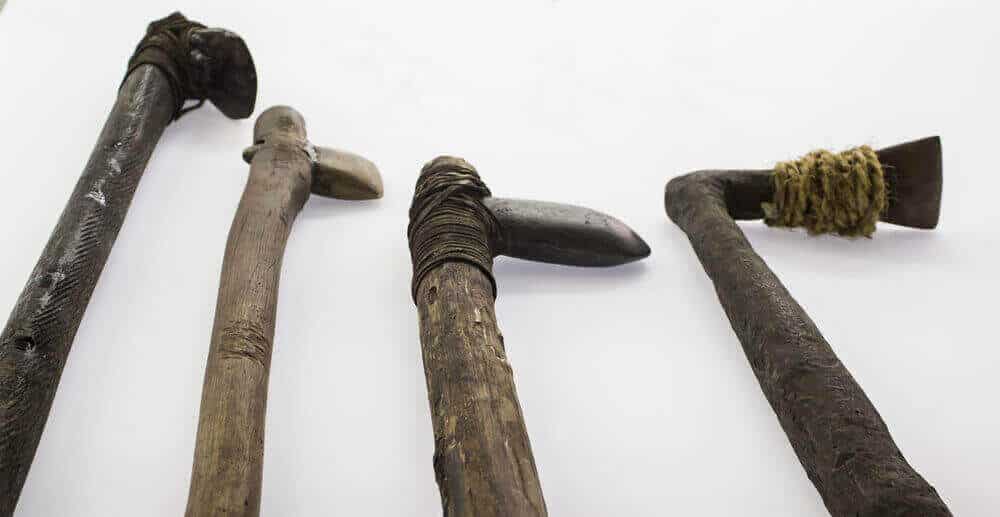The Stone Axe is one of human history’s earliest and most essential tools. It was a game changer for early humans, allowing them to build settlements, clear agricultural land, and defend themselves against predators. Despite being a simple tool invented around 1.5 million years ago, the Stone Axe profoundly impacted human history during the Lower Paleolithic period and remains an important symbol of our early ancestors’ ingenuity and resourcefulness.
Table of Contents
The Significance Of The Stone Axe
The stone axe is a prehistoric tool that attaches a sharpened stone to a wooden handle. The Stone Axe was created by chipping away at a piece of stone until it had a sharp edge from materials such as basalt, granite, and flint. Over time, humans developed more advanced techniques for making stone axes, including polishing and grinding the edges to make them sharper and more durable. Early humans utilized stone axes until the Bronze Age, when metal axes began to replace them.
The significance of the stone axe extends beyond its practical uses. It also held symbolic and religious importance in many cultures. The stone axe was a status symbol in some societies, and only the most skilled artisans could make them. In other cultures, the stone axe was used in ritual ceremonies and was believed to have magical powers.
Stone axes are among human history’s most essential and widely used tools. Archaeologists have found stone axes at numerous archaeological sites worldwide, including Europe, Africa, China, Australia, and New Guinea. These objects have been studied in great detail and have provided valuable insights into the lives of our ancestors.
One of the most significant aspects of stone axes is their durability. Many of these objects have survived for thousands of years, allowing us to study them in detail and better understand the people who made and used them. By examining the wear patterns on these objects, archaeologists can determine how they were used and what tasks they were used for.
Stone axes are also vital because they provide evidence of early settlement patterns. For example, archaeologists have found stone axes at the Avebury site in Britain, which suggests that this area was inhabited as early as 3000 BC. Similarly, stone axes have been found at numerous graves and settlements throughout Europe, providing valuable insights into the lives of our ancestors.
These objects have played a crucial role in our understanding of human history and continue to be studied extensively by archaeologists worldwide. By examining these objects under a microscope and conducting detailed analyses of their wear patterns, we can better understand the lives of our ancestors and the world they inhabited.
Materials and Production of Stone Axes
The materials used in making a stone axe vary depending on the region and time period. The most common stone used for making axes was flint or chert due to its ability to hold a sharp edge. Other materials, such as slate and quartzite, were also used but were less durable than flint.
The production of stone axes involved several steps, including hafting, grinding, and knapping. Hafting involves attaching the stone blade to a wooden handle using adhesive or a socketed design. Grinding was to shape the blade and create a smooth edge, and knapping made the blade by striking the stone with a pressure or wedge tool.
Stone axes were used not only as chopping tools but also to shape other stones into tools such as knives and scrapers and experiments in producing new tools, such as arrowheads, mauls, and gouges. They were valuable commodities often used for trade between different tribes and communities and were a form of currency.
Varieties Of Stone Axes
Stone axes were one of the earliest tools used by humans for various purposes, including cutting, shaping, and hunting. From the primary axe design in multiple sizes, artisans also began to create other shapes, such as an adze. Over time, different varieties of stone axes were developed, each with unique features and uses.
Large Stone Axes – Large stone axes were typically used to fell trees and chop wood. These axes had a long handle made of wood that provided leverage and allowed the user to swing the axe with greater force. The cutting edge of the axe was wide and sharp and could be used to split logs or cut through thick branches.
Hand Axes – Hand axes were smaller and more portable than large stone axes and were used for cutting meat, scraping hides, and shaping wood. These axes had an oval shaped cutting edge and operated with one hand. Some hand axes had a wooden handle attached to the stone head for better grip and control.
Adzes: Adzes were similar to hand axes but had a curved cutting edge to shape wood. Ancient civilizations commonly used these tools for carving wooden objects such as bowls and spoons.
Wedges – Wedges were a type of stone axe with a sharp, wedge shaped edge for splitting wood and were used by early farmers to prepare firewood and building materials.
Hatchets – Hatchets were small, handheld axes for chopping, kindling, and trimming branches. These axes had a short handle and a sharp cutting edge and were commonly used by hunters and outdoorspeople. To learn more about hatchets and tomahawks read our guide Tomahawks and Hatchets: Differences & Similarities.
The stone axe was eventually replaced by the iron axe, which was a more efficient cutting tool. The iron axe had a sharper cutting edge and was more durable than the stone axe. However, the stone axe continued to be used in some areas long after the introduction of the iron axe.
Final Thoughts
The stone axe was an essential tool to shape and cut wood for building structures, furniture, and other items during the Stone Age. They were a critical tool for farmers, hunters, and fishermen and used for trade, experimentation, and tool production. The stone axe played a significant role in developing cutting tools and was eventually replaced by the more efficient iron axe.
Frequently Asked Questions
What was the purpose of stone axes?
Stone axes were tools for cutting and shaping wood, bone, and other materials. They were also used for hunting and as weapons in some cultures.
What is the name of the oldest known stone axe?
The oldest stone axe is the Tasmanian axe, estimated to be around 35,000 years old.
What is the significance of the stone axe in human history?
The stone axe played a significant role in human history as it allowed for the development of agriculture, the construction of buildings, and the creation of weapons. It was a crucial tool for survival and advancement in ancient cultures.






